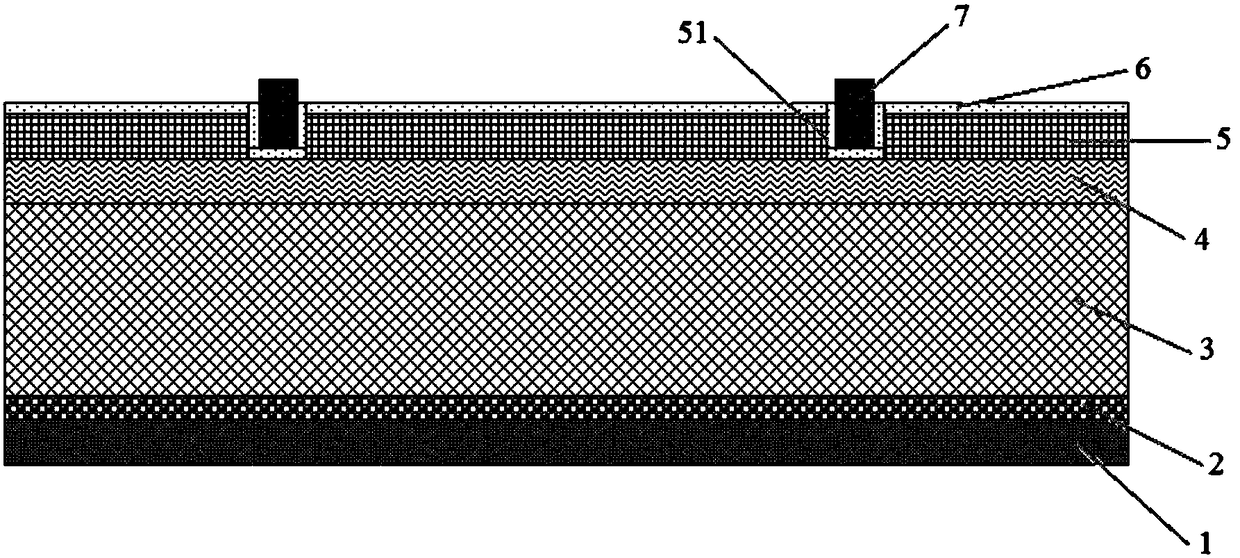Monocrystalline silicon solar cell and production method thereof
A technology for solar cells and manufacturing methods, applied in the field of solar cells, capable of solving problems such as N-type silicon layer damage and affecting the photoelectric conversion efficiency of P-type monocrystalline silicon solar cells, so as to reduce defect states, improve photoelectric conversion efficiency, and reduce leakage The effect of current
- Summary
- Abstract
- Description
- Claims
- Application Information
AI Technical Summary
Problems solved by technology
Method used
Image
Examples
Embodiment 1
[0020] A method for manufacturing a monocrystalline silicon solar cell, comprising the following steps: (1) forming a textured layer on the upper surface of a P-type monocrystalline silicon wafer; (2) forming a N layer on the upper surface of the P-type monocrystalline silicon wafer. (3) deposit a silicon nitride passivation layer on the N-type silicon layer, and etch the silicon nitride passivation layer to form an opening in the area where the upper electrode is to be formed to expose The N-type silicon layer; (4) Spin-coat a solution containing acetoalkoxy aluminum diisopropoxide on the upper surface of the P-type single crystal silicon wafer, and perform annealing treatment to passivate the silicon nitride (5) sequentially spin-coat the solution containing tungsten sulfide two-dimensional nanomaterial and the solution containing tungsten sulfide on the lower surface of the P-type single crystal silicon wafer A solution of titanium two-dimensional nanomaterials, and anneali...
Embodiment 2
[0024]A method for manufacturing a monocrystalline silicon solar cell, comprising the following steps: (1) forming a textured layer on the upper surface of a P-type monocrystalline silicon wafer; (2) forming a N layer on the upper surface of the P-type monocrystalline silicon wafer. (3) deposit a silicon nitride passivation layer on the N-type silicon layer, and etch the silicon nitride passivation layer to form an opening in the area where the upper electrode is to be formed to expose The N-type silicon layer; (4) Spin-coat a solution containing acetoalkoxy aluminum diisopropoxide on the upper surface of the P-type single crystal silicon wafer, and perform annealing treatment to passivate the silicon nitride (5) sequentially spin-coat the solution containing tungsten sulfide two-dimensional nanomaterial and the solution containing tungsten sulfide on the lower surface of the P-type single crystal silicon wafer A solution of titanium two-dimensional nanomaterials, and annealin...
Embodiment 3
[0028] A method for manufacturing a monocrystalline silicon solar cell, comprising the following steps: (1) forming a textured layer on the upper surface of a P-type monocrystalline silicon wafer; (2) forming a N layer on the upper surface of the P-type monocrystalline silicon wafer. (3) deposit a silicon nitride passivation layer on the N-type silicon layer, and etch the silicon nitride passivation layer to form an opening in the area where the upper electrode is to be formed to expose The N-type silicon layer; (4) Spin-coat a solution containing acetoalkoxy aluminum diisopropoxide on the upper surface of the P-type single crystal silicon wafer, and perform annealing treatment to passivate the silicon nitride (5) sequentially spin-coat the solution containing tungsten sulfide two-dimensional nanomaterial and the solution containing tungsten sulfide on the lower surface of the P-type single crystal silicon wafer A solution of titanium two-dimensional nanomaterials, and anneali...
PUM
 Login to View More
Login to View More Abstract
Description
Claims
Application Information
 Login to View More
Login to View More - R&D
- Intellectual Property
- Life Sciences
- Materials
- Tech Scout
- Unparalleled Data Quality
- Higher Quality Content
- 60% Fewer Hallucinations
Browse by: Latest US Patents, China's latest patents, Technical Efficacy Thesaurus, Application Domain, Technology Topic, Popular Technical Reports.
© 2025 PatSnap. All rights reserved.Legal|Privacy policy|Modern Slavery Act Transparency Statement|Sitemap|About US| Contact US: help@patsnap.com

